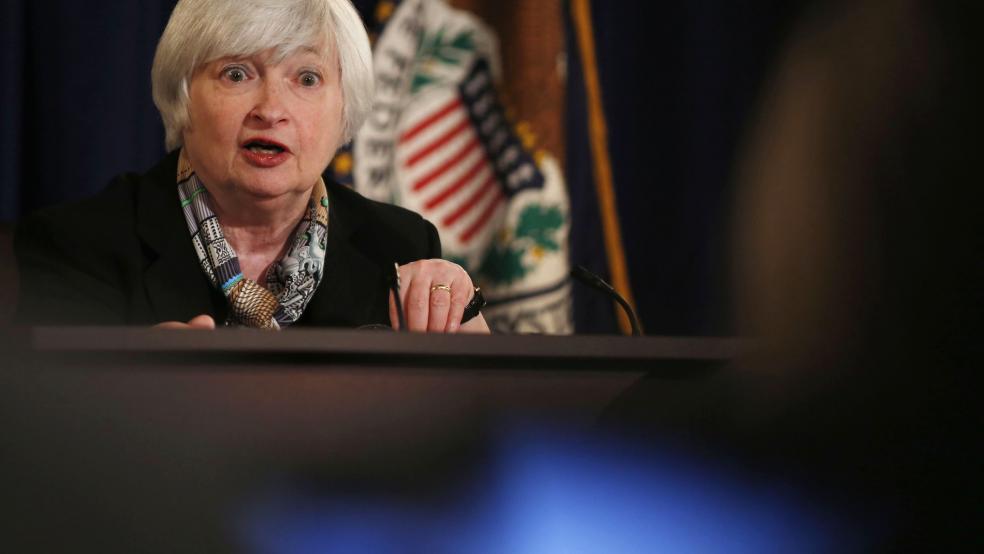The Fed’s target interest rate has been at the zero lower bound since December of 2008, and Fed watchers are trying to predict when the Fed will begin reversing this policy. The consensus appears to be that the Fed will begin raising the target rate at the beginning of next year, but many economists believe the policy reversal should have already started. There are four main justifications for the call to raise interest rates sooner rather than later, all of which are misguided:
Rules vs. Discretion: Stanford’s John Taylor believes that monetary policy works best when it adheres to specific rules. In particular (and unsurprisingly), he is an advocate of the Taylor rule that links the target interest rate to changes in output and inflation. He argues that when the Fed exercises discretion and deviates from specific rules in response to changing economic conditions, either by adopting new rules or by altering how it responds to variations in output and inflation, it creates uncertainty that harms economic performance. According to Taylor, if the Fed had followed the Taylor rule after the crisis started, a rule that would have prompted the Fed to begin raising interest rates in 2011, we could have had a “V-shaped” recovery.
Related: A Close Eye on the Fed for the Path of Interest Rates
But no rule, no matter how complex, can anticipate all contingencies, and when the economy is experiencing conditions a rule could not have foreseen, as it did during the Great Recession, deviations from the rule are necessary. Raising interest rates in 2011 would not have aided the recovery, and the same is true today. Any benefit from the reduction in uncertainty would be small and would not compensate for the negative effect that higher interest rates would have on business investment, mortgage activity, and the consumption of durable goods such as automobiles – all of which are essential to the recovery.
Helping Savers: Some have argued that we need to raise interest rates to help savers. But when the economy is experiencing a severe recession, the demand for investment is low, so low that even at zero interest rates there can be an excess of saving over investment. In this case, negative interest rates are needed to reduce saving and increase investment until equilibrium is restored, but negative rates are precluded by the zero bound (a fuller explanation is here).
This has been a problem during the Great Recession, and following the advice to raise interest rates would increase saving, decrease investment, and make the disequilibrium larger. Even worse, the fall in investment would make it harder for the economy to recover.
Related: What Rising Rates Mean for Home Prices
Threat of Inflation: There have been many calls to raise interest rates to reduce the risk of inflation, but there is no sign whatsoever of problematic inflation anywhere on the horizon. End of story.
Threat of Deflation: The relationship between real and nominal interest rates is captured by the Fisher equation: i = r + pe, where i is the nominal interest rate, r is the real interest rate, and pe is the expected rate of inflation. Some economists have argued that when policymakers hold the nominal interest rate at the zero bound, it is deflationary since r is positive, and pe = -r when i=0.
To avoid the possibility of deflation and all of the problems that come with it, proponents of this view argue that policymakers should raise the nominal interest rate. Why would this work? The argument is that since the real interest rate, r, is relatively constant in the long-run, raising the nominal interest rate would raise inflationary expectations (because people know that the Fisher equation must hold) and that would cause actual inflation to rise.
Related: Rising Interest Rates Will Slam the Federal Budget
Even if this does work in the long-run, in the short-run it would be a disaster. Inflation is ultimately driven by the demand for goods and services relative to supply. When demand exceeds supply, prices and inflationary expectations rise. But it’s hard to see how an increase in the nominal interest rate would cause people to expect an increase in demand and a subsequent increase in prices. If the increase in the nominal interest rate is not accompanied by an increase in inflationary expectations, then the Fisher equation tells us that the real interest rate will rise. That would be very harmful to an economy struggling to recover from a recession.
Instead, what is needed is to lower the interest rate when a recession hits to stimulate the economy, and then as the economy recovers and inflation threatens, raise the interest rate to choke off the inflationary pressure. Thus, the increase in the target interest rate must follow the recovery, it cannot lead it – that would cause real interest rates to rise and endanger the economy’s ability to return to full employment.
***
Although there have been many calls for the Fed to raise its target interest rate, the Fed has made it clear that it intends to keep its target interest rate abnormally low even after the economy is well into recovery. There may be some risk of inflation in this approach, but as noted above this risk appears to be small. The bigger risk is raising rates too soon and choking off the recovery of employment and output, and the Fed has wisely chosen to minimize this possibility.
Top reads from the Fiscal Times:






